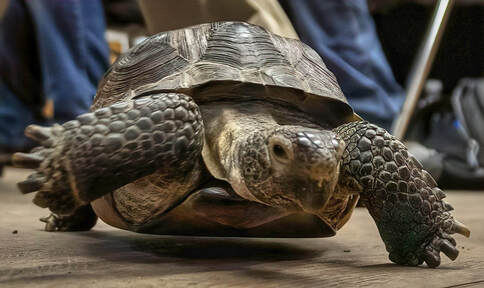Gopher Tortoise

Common Name: Gopher Tortoise
Scientific Name: Gopherus polyphemus
Physical Description: Gopher Tortoises are 10-16 inches on average and grow up to 30 pounds1. They are grey, brown, and black in color, and have scales on their limbs for protection. Their front legs are broad and flat, suited for digging their burrows, and their plastron (lower shell) is flat in females and concave in males.
Habitat: They live in dry, upland areas such as scrub, sand hills, coastal dunes, and pine flatwoods.
Range: They are found in the southeast United States from South Carolina to Louisiana and down through Florida1
Diet: They eat grasses, legumes, and fruit
Life Span: The Gopher Tortoise lives 40-60 years2 in the wild and up to 100 years in human care.
Social Structure: Like many reptiles, the tortoise provides no parental care to its offspring.
Status: Vulnerable3
Other: The Gopher Tortoise is a keystone species, or a species in which the local ecosystem relies on for services. The Gopher Tortoise digs long burrows which provide refuge to over 300 other species including insects, birds and snakes.
[1] https://buffalozoo.org/animal/gopher-tortoise/
[2] https://myfwc.com/wildlifehabitats/profiles/reptiles/gopher-tortoise/
3 https://www.iucnredlist.org/species/9403/12983629
Scientific Name: Gopherus polyphemus
Physical Description: Gopher Tortoises are 10-16 inches on average and grow up to 30 pounds1. They are grey, brown, and black in color, and have scales on their limbs for protection. Their front legs are broad and flat, suited for digging their burrows, and their plastron (lower shell) is flat in females and concave in males.
Habitat: They live in dry, upland areas such as scrub, sand hills, coastal dunes, and pine flatwoods.
Range: They are found in the southeast United States from South Carolina to Louisiana and down through Florida1
Diet: They eat grasses, legumes, and fruit
Life Span: The Gopher Tortoise lives 40-60 years2 in the wild and up to 100 years in human care.
Social Structure: Like many reptiles, the tortoise provides no parental care to its offspring.
Status: Vulnerable3
Other: The Gopher Tortoise is a keystone species, or a species in which the local ecosystem relies on for services. The Gopher Tortoise digs long burrows which provide refuge to over 300 other species including insects, birds and snakes.
[1] https://buffalozoo.org/animal/gopher-tortoise/
[2] https://myfwc.com/wildlifehabitats/profiles/reptiles/gopher-tortoise/
3 https://www.iucnredlist.org/species/9403/12983629






